
Touch upon a countercurrent or unpopular topic with your friends and you're most likely to get that in response.
Maybe a frown and a familiar look of skepticism.
Because whether you like it or not, people will always have their assumptions and prejudices.
It can take you a long time to convince them that something is doable—if you can even convince them at all.
The world of SEO and webmasters is no different.
One of the most common assumptions in SEO is that you can't rank a website without building quality backlinks.
But, I'm here to tell you that you can.
It’s definitely possible to rank without backlinks.
Keep reading to find out what I mean—and yes, I'm absolutely serious!
(I do it all the time.)
Why You Should Consider Trying to Rank Without Backlinks
I'm an introvert and a Highly Sensitive Person.
I don't like pitching, it stresses me out.
Finding link building opportunities is one heck of a handful for me. So guess what I do when it comes to SEO?
I try to rank my websites without backlinks.
Now that's just me, but there are tons of valid reasons you might want to try this method instead of deep-diving into link building and outreach right away.
A few "because" cases:
- Your website is new and has to establish authority before seeking external validation for it
- Your website is in a niche that hardly gets any backlinks (e.g. plumbers, local ice cream shops)
- Your website is not content-rich for service reasons (e.g. portfolio, business listings)
If you're in any of these situations, it might make more sense for you to focus on SEO strategies that don't involve link building—at least for now.
The seven strategies I've shared below will help you rank your website with on-page SEO, valuable content and off-page mentions.
No sign of backlinks anywhere.
In fact, if you focus on creating value and optimizing your content on-page, you can skip (or at least postpone) going out to seek link-based external signals, because your site can still rank without them.
And I'll bring you a case study here to bring home my point:
- Ted Chong managed to boost the rankings of a private education provider's website from Page 2 of the SERPs to result #2, Page 1. This was done entirely through content creation and optimization for a competitive local keyword, with no link building.
So, I guess now is a good time to introduce the strategies, isn't it?
1. Don’t Be Shy—Create Value!
It's easy to start a blog or add informative pages to your website.
But you couldn't say the same about creating value.
You can't just create a random opinion post about [insert topic here] and call it a valuable piece of content.
You can't be shy when it comes to solving people's problems.
No—you have to answer the searcher's query thoroughly.
They have to leave the page with a sense of satisfaction that says "Yes! This is the answer to my problem that I was looking for."
(You can have opinion pieces in the mix, sure—just don't make them 100% of your total content.)
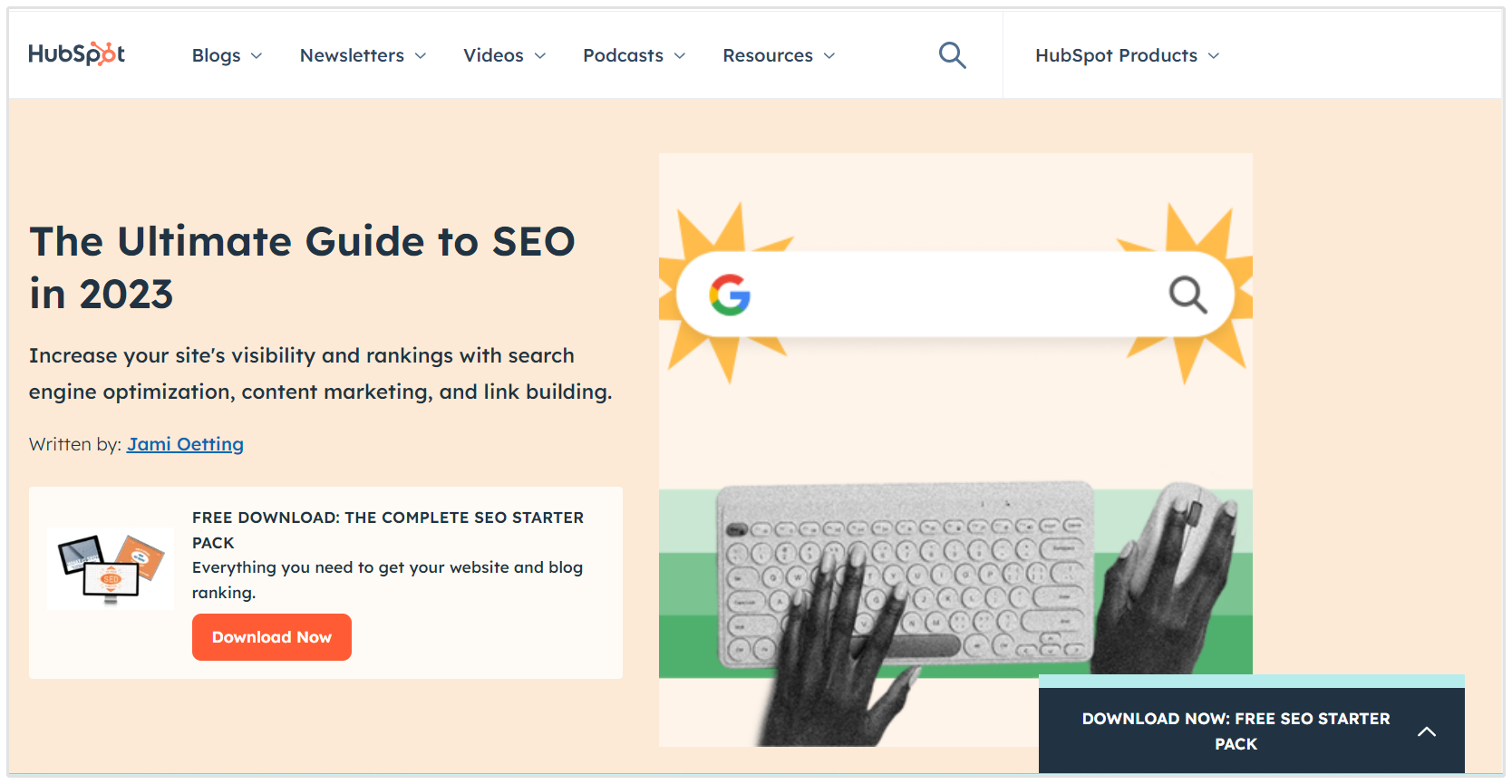
Take Hubspot's Guide to SEO, it's nearly 6000 words long and covers most of the topics you'd need to learn about to get started with SEO. Their blog post is a comprehensive and valuable piece of content and it's no wonder that their blog post is first in the SERPs.
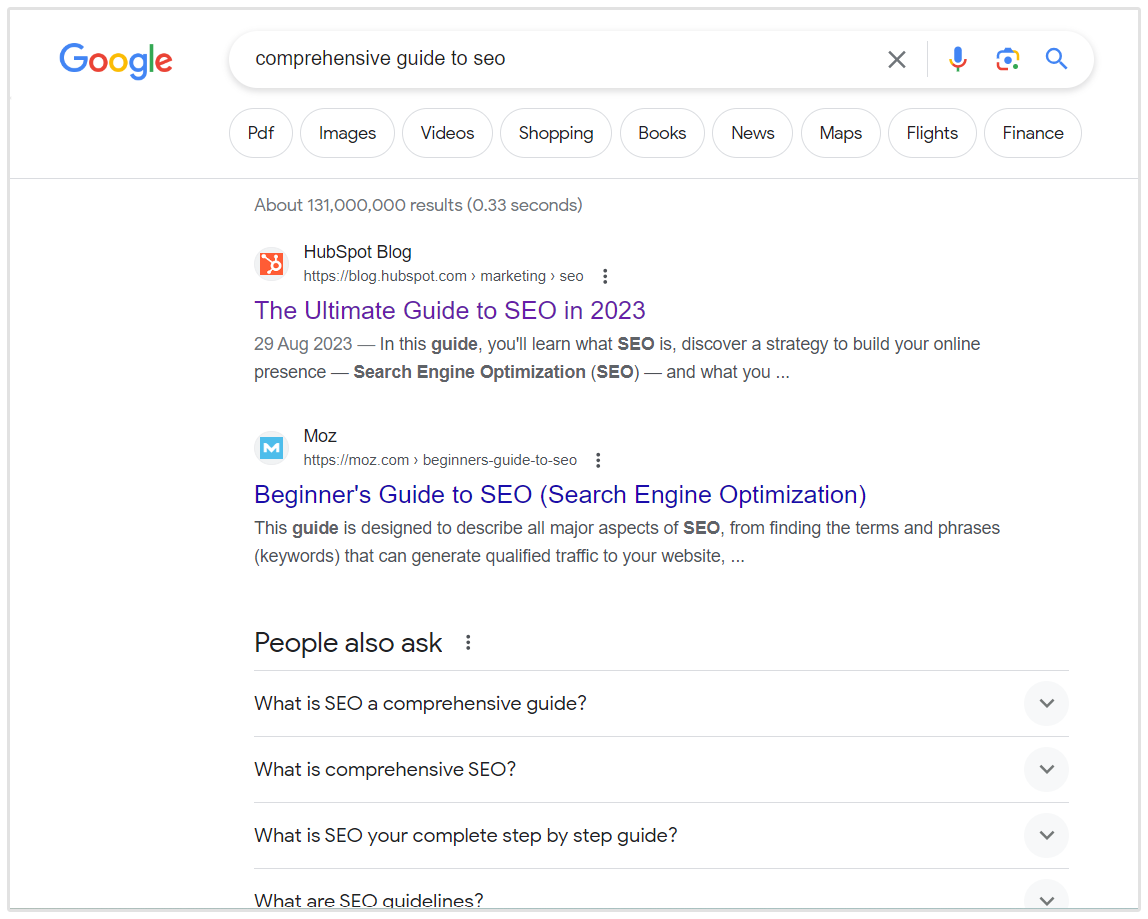
Chad Zollinger, chief editor at Best Company, is a fan of content cocktails, a concept that I found fascinating and effective:
"For those who really want to dominate their industry's search results, use the content cocktail.
A content cocktail helps you tailor your content exactly to your audience (3 story-driven videos + 10 long-form articles + 1 e-book = a great content cocktail)."
Zollinger is determined to effectively answer a search query for the user's benefit and to achieve that first page ranking we're all after—without the aid of any kind of backlink.
The secret, according to Zollinger:
"[Write] better content than the top 10 articles for your target keyword."
It's that simple.
But it takes hard work, too. You have to go more in-depth with your content, provide clear answers and include graphics that help the reader understand the concepts.
SEO consultant Francesco Baldini also agrees that content is central to a rank-without-backlinks type of strategy.
He talks about focused content.
In the case study he devoted to it, Baldini shows how a year-old website is getting a big advantage in terms of user satisfaction and Google rankings compared to its competitors—and all with less than 30 pages in total.
Baldini suggests two main things:
- Implement a content creation strategy to attract visitors with proper keyword research that focuses on search intent and the stage of the funnel your users are at, and
- Keep Google's recent Medic Update in mind when you evaluate the E-A-T (Expertise, Authority, Trust) of your site.
In other words, be that great teacher all students love to learn from!
2. Go Longtail and Low Volume with Your Keywords
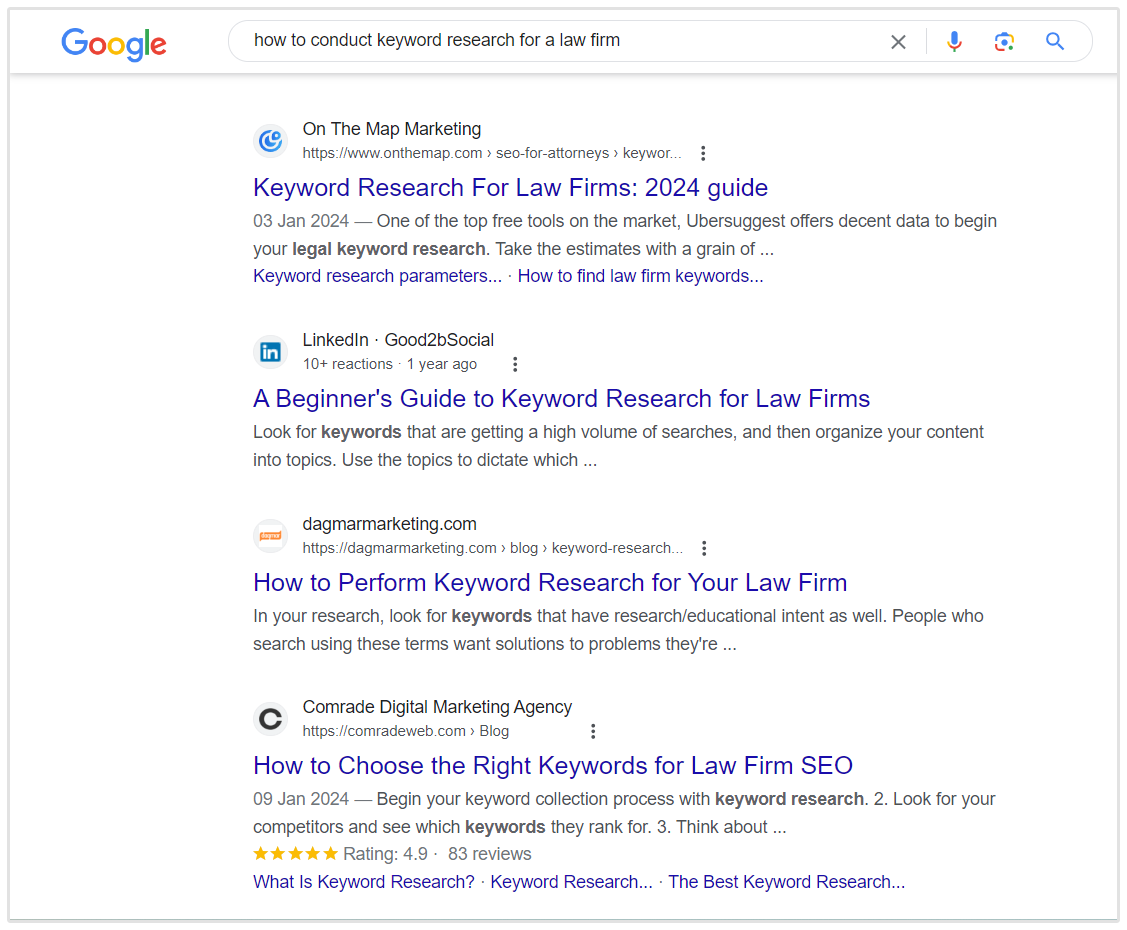
We just covered answering searchers' queries in the best way possible.
Now, the next step is to find those very niche, super specific, low-volume keywords that you know for certain you stand a chance of outranking your competitors for.
These keywords are called longtail keywords and they're your friends.
With lower search volume and less competition, they're much easier to rank for compared to the high-level competition you must battle daily for the most popular search terms.
Joseph Sloan from Advice Media is a big fan of longtail keywords. The way he puts it is genial:
"You should always aim to be the Wikipedia of your industry!"
Sloan shared with me an interesting case study for one of his clients (a sand seller), about how his team of six people got them to rank well with longtail content marketing only—no link building.
In the daunting world of SEO, they set a goal for this client to become the local Wikipedia of sand.
And so, they set to provide content that answers every inquiry a user might have about buying sand.
Sloan kindly shared a screenshot of a result obtained for one of these kinds of Wikipedia-style articles they created.
The piece of content, ranking #1 on Page 1 of the SERPs, answers the searcher's question "How much sand does a green turtle sandbox take to fill?" by targeting the longtail, low-volume query "how much sand does a green turtle sandbox:"
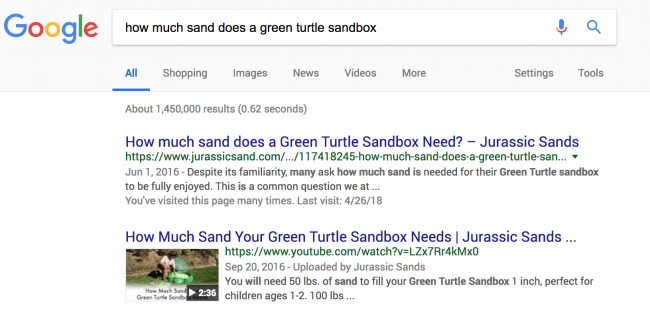
Other strategies Sloan and his team used to improve rankings involved regular on-page SEO, such as the optimization of HTML tags, page hierarchy and the addition of multimedia content (videos, animations, images) to keep users on the site and engaged.
But Sloan told me more about the success achieved for this client thanks to the longtail "Wikipedia" approach:
"The most amazing part is this has resulted in huge spikes in traffic over the summer months to his site, helping build brand awareness. Nearly quadrupling the traffic to our site over the summer months.
Also, this single blog post has resulted in thousands of dollars in sales, and the best part is the ROI gets better every summer because this is terrific evergreen content!
These results were very quick, rankings happened within a week of the content going live and without any backlinks!"
He also shared the screenshot below:
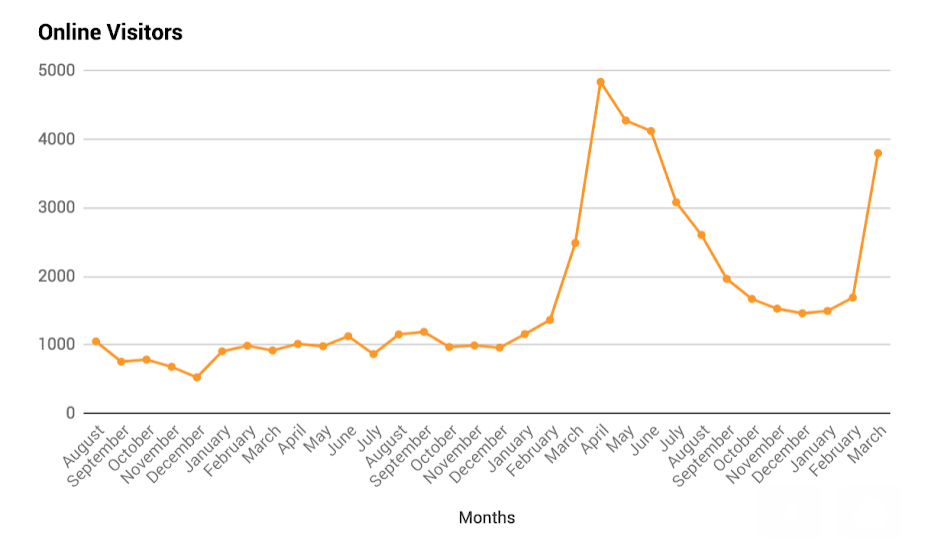
That's quite the spike!
The good thing is that traffic stayed close to the 2k mark even after that, in the last quarter of the year, and then it went up again in the new year.
Not bad for a link-less job!
But it's not so surprising. Low-volume, longtail keywords make it easy to rank exceptional content without the help of links, because they're very niche and you generally have fewer competitors to stand in your way.
So give it a try!
3. Get Customer Reviews
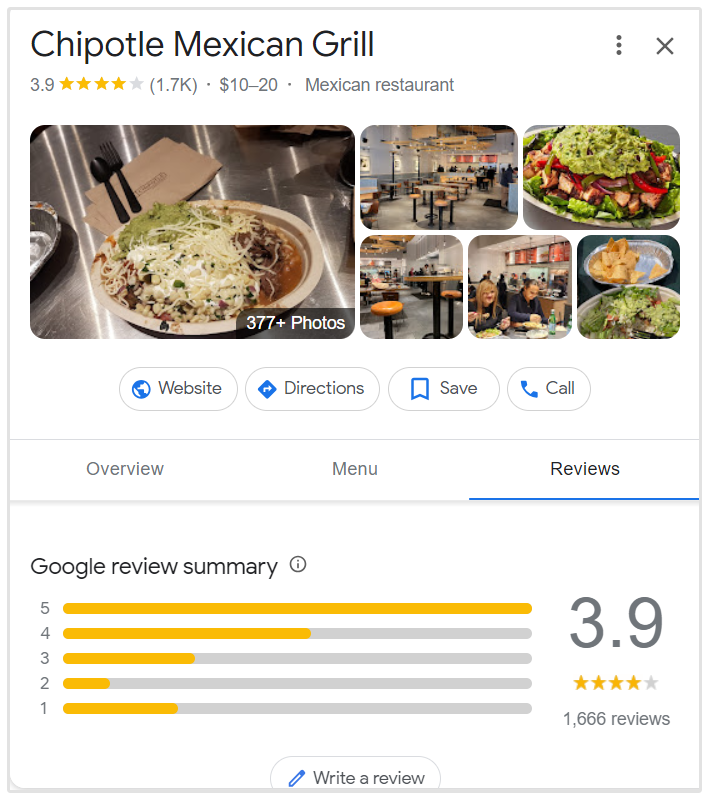
Customer reviews are by far one of the most powerful inbound sales tools for small businesses with a local presence, especially if competing directly with larger companies would wipe out your small marketing budget.
If this is your case, focusing your attention on customer reviews will only bring you good.
You can always plan a link building campaign later.
I got talking with Chas Cooper, CEO and founder of Rising Star Reviews, about this.
He said that because Google thinks of each positive customer review as a vote for the business, each review added to the pile helps businesses rank higher in search results and get listed in Google's local 3-Pack.
And what does Google consider with customer reviews?
Definitely not the link to the company's website (there is none). Instead, what matters to Google is:
- The number of stars the reviewer gave the business
- Any relevant keywords the reviewer used in their review
- The sentiment of the review (words and phrases with positive emotional content versus negative emotional content)
Mike Khorev, growth lead specialist at Nine Peaks Media, also shared his experiences with me and confirmed that reviews are critical to local SEO:
"One of our cell phone repair shops was able to rank on the first page of Google organically and top 3 in Google Maps by having a locally optimized website, adding their business to 50 local directories, and driving 30 positive reviews on Google Maps.
By optimizing the most important ranking factors for local SEO, they were able to get 100 calls and 30 store visits every month."
The core takeaway is that if you're a local brick-and-mortar business aiming to get one of the top 3 spots on Google Maps, you can do this without backlinks.
What matters is:
- Your Google My Business account
- Building citations on local directories
- Getting positive reviews from customers
Then, of course, you can up your visibility game with a good local link building plan. But that's for later, after you have your solid foundations to build upon.
4. Earn Mentions and Citations
Not every business or website owner has the budget to go all in on an aggressive link building campaign.
Especially if you're just starting out, your resources might be limited and your brand might not be reputable enough yet to attract authoritative linking signals.
So how can you build that reputation?
Getting cited is a start.
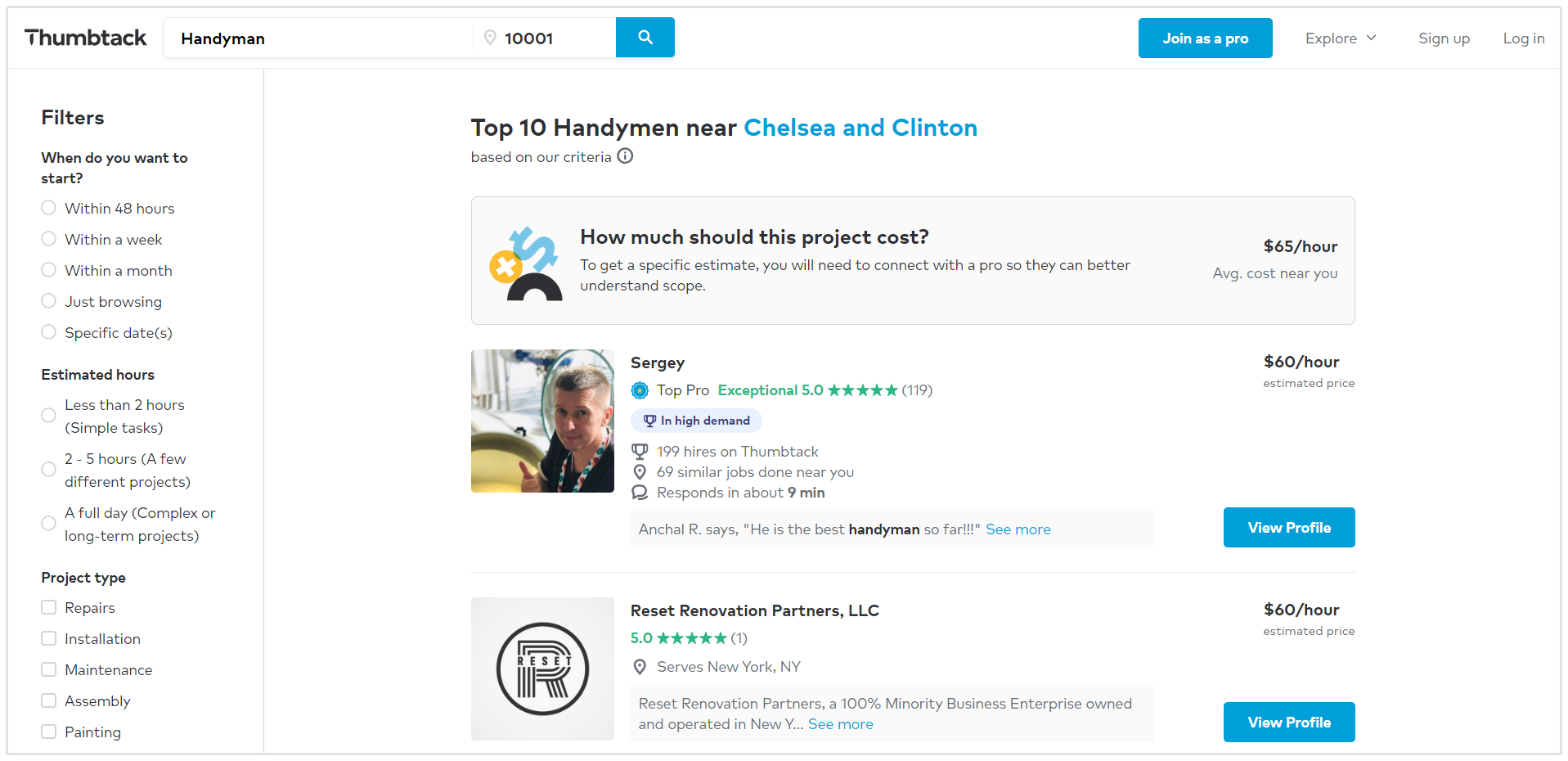
By that I mean full unlinked URLs and brand citations.
It's the way online bibliographies work:
You produce a trustworthy piece of content documenting a case study, research or survey results, and you immediately earn the authority for being a researcher in that area. You don't need to be an academic to do your research!
Plus, Google does count citations as ranking signals.
Brandon Seymour from Beymour Consulting told me how he witnessed this particular backlink-less strategy to be a win, especially for local businesses:
"I've seen plenty of SMBs achieve front page visibility, many times in the top 3 positions, without any link building what-so-ever.
Keep in mind, I've only seen this work in what I would consider mildly competitive niches. The bigger the market, the less likely you are to rank without links."
Another way to gain visibility quickly on search engines is through social media mentions.
Social media is where your website and its content gets known.
And once it's known, it gets searched for.
Because your audience uses both search engines and social media to find content of interest, it's easy to find a correlation between the engagement and loyalty your website gets on social media and the increasing number of searches and clicks it gets on search engines.
I'm mainly talking about brand searches, but you could actually get found for other keywords via social media, too.
5. Copy Your Competitors’ On-Page SEO Strategy
It's never too late to learn from your competitors, especially if they've been playing the SEO game long before you!
Among the many cool people I contacted for this article, SEO professional Jeff Lenney also uses a successful no-backlinks strategy, and it's based entirely on studying the competition.
These are the steps he recommends taking:
A. Review Your Competitors on Page 1 of the SERPs for a Given Keyword
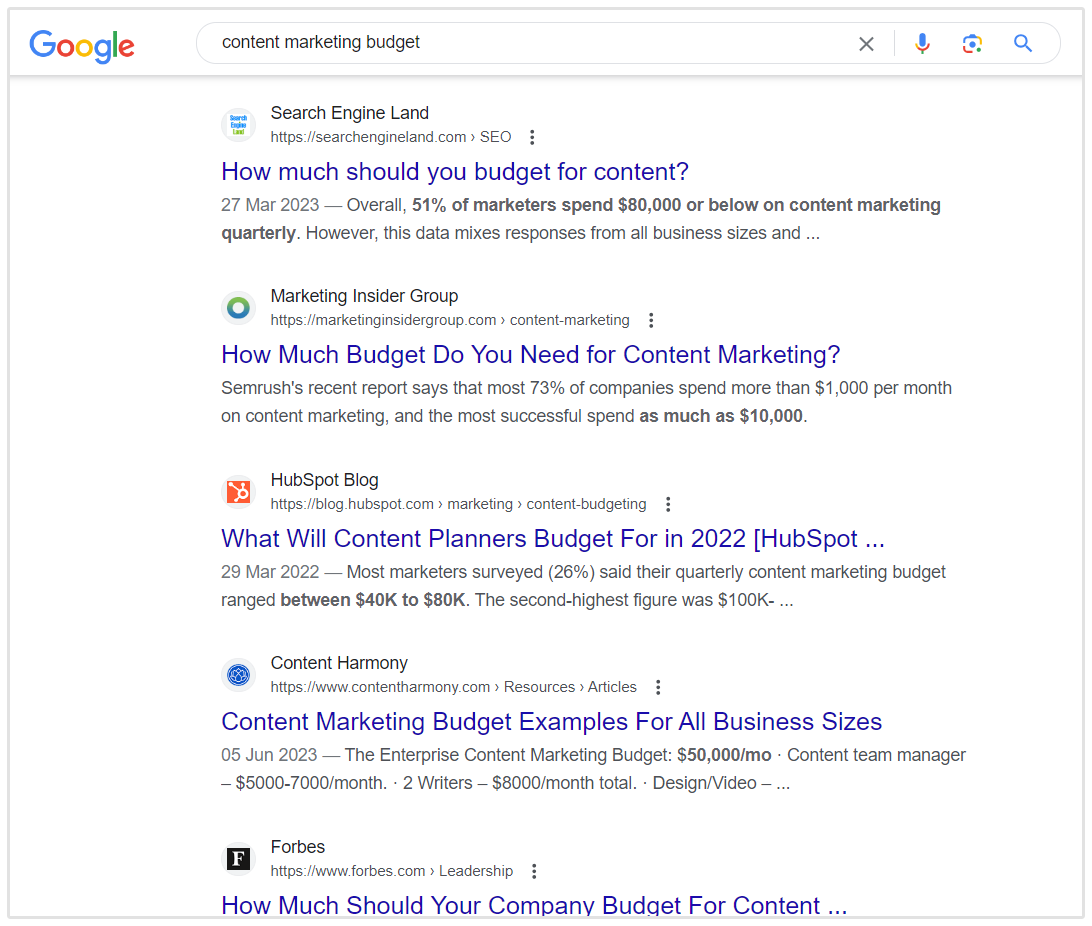
A quick Google search for "content marketing budget" (search volume: 70/mo) returns content from big blogs on Page 1, including Search Engine Land, Marketing Insider Group,Hubspot, and Forbes.
Most of these websites are high authority competitors for my small SEO and marketing blog. So, that means there's plenty to learn from!
Make sure you also check out the other guide I wrote on how to "spy" on your competitor's backlinks—it's not unethical and it can refill your SEO idea well when it's starting to run dry.
B. Find Their Average Number of Words per Page
That's your "word count goal," as Lenney calls it.
You're going to use it as a metric for content quality, meaning that every piece of content you publish will be as thorough as possible and fully answer the searcher's query.
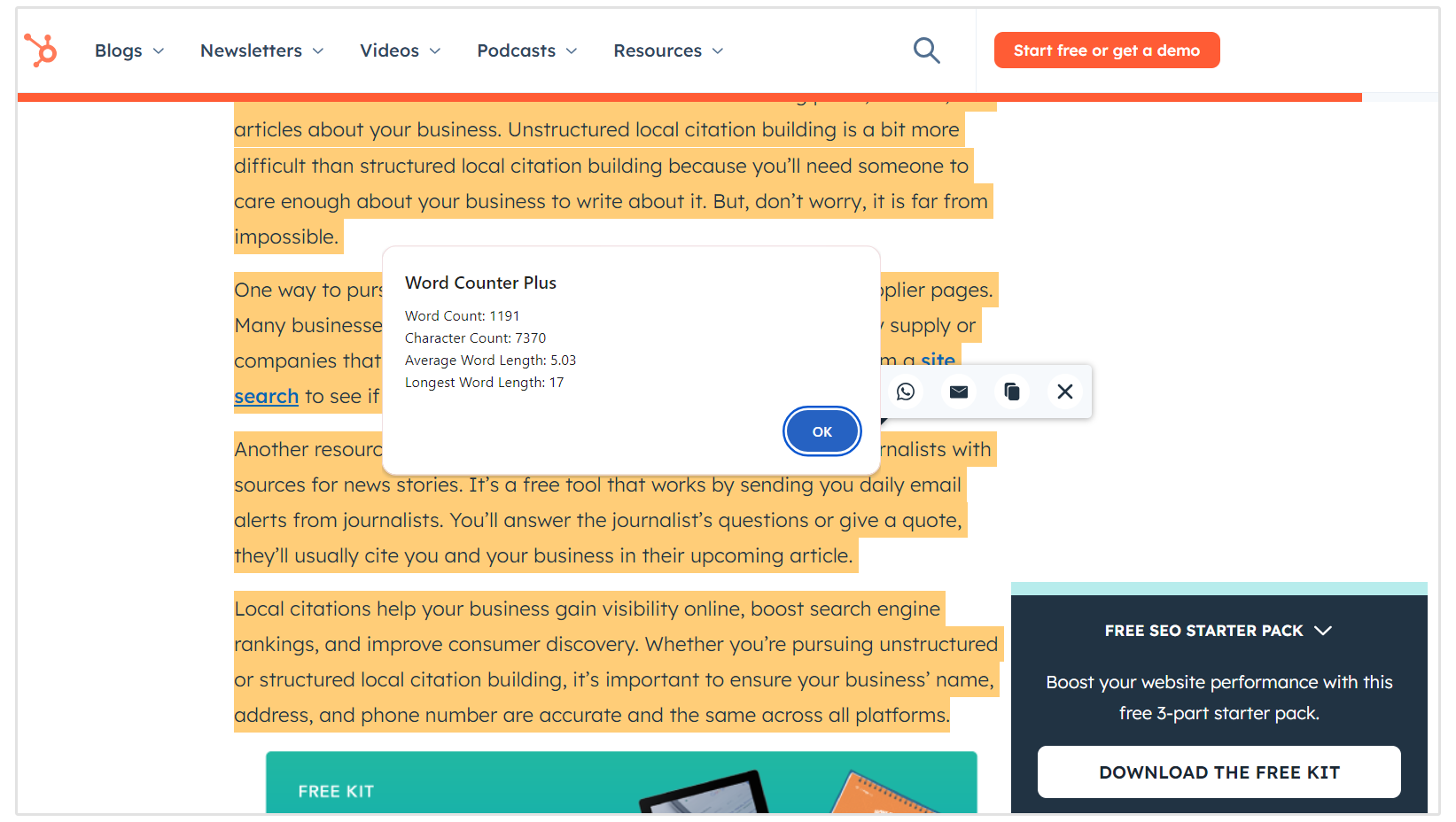
For example, let's say the two top ranking posts for a given keyword have 1,428 and 2,059 words respectively. (You can use Word Count Tool , WordCounter, or Word Counter Plus to quickly find the word count of a page.)
To find the average word count, I add up the two numbers and then divide the result by two:
(1,428 + 2,059) / 2 = 3,487 / 2 = 1,743.5
So 1,743 is the average word count goal I want to reach for each of my own blog posts on a similar topic.
Not a huge post like the one you're reading, but long enough to satisfy the searcher's hunger for knowledge.
C. Write Your Content to That Word Count Goal, if not a Little More
Pretty self-explanatory!
As well as creating new content, you can also go through and update old content to bring it closer to your word count goal.
D. Take Note of Other Trends to Get an Idea of What Your Competitors on Page 1 are Doing to be Worthy of the Top Positions
Examples of such trends are:
- How many times they use the keyword in their header tags
- How many images they use per piece of content
- How many videos they use per piece of content
- How many internal links they added per piece of content
It's surprising how much free information a competitor can give you by just existing on the web, isn't it?
Lenney was kind enough to share this pretty clever strategy with me, and I've started to use it myself to learn from the on-page SEO of my competitors.
6. Build Internal Links
.png)
There's still something else to consider: the actual backlinks that every website gets.
Seriously, no website can exist without any backlinks at all—and that's not denying anything said so far in this article.
Because you see, there's one kind of backlink that's always going to be there and that's super easy to acquire: internal links.
Yep, you read that right. Every website interlinks its own pages, so it's actually impossible to say that your site has no backlinks at all. As you can see in the example above, we've linked to our blog post about increasing organic traffic from another blog post about CTR.
Now, I already mentioned earlier that internal links are part of any good on-page SEO strategy, but these links carry much more value than what they seem at first sight.
They can be keyword optimized and built like any other inbound backlink.
Call it your self-managed link building strategy.
Previously mentioned expert Jeff Lenney uses this method as well, and he doesn't just stop at regular internal links.
He pushes the concepts of relevancy and natural linking to these links, which is a tremendously good idea to stay in Google's and users' good books (and get people clicking them!):
"Add as many relevant internal links from other posts and pages on your website back to your target page.
Make sure you vary your anchor text (e.g. use things like 'lose weight' and 'lose weight quickly'). It doesn't have to match your keyword exactly, and it's usually better to vary the anchor text to look more natural."
But I particularly appreciated what Jim Woodhead from Jaywood Agency told me about making internal links his battle horse with clients.
This is the advice he shared with me:
"Look at your website’s internal linking and supporting pages.
Can you create 7 or 8 supporting pages that talk about that keyword? You need a body of content on your site so that you can build your overall authority on the topic and within the niche.
Then work hard on your internal linking. Have optimized internal links that point to your main content page.
You have to give Google all of the possible signals so that it can read your content and say 'hey, I like those pages, let’s get them in front of searchers.'"
It worked for Woodhead.
He and his team ranked pages and sites above link-heavy competitors and major players like Amazon and Wikipedia by targeting specific keywords, producing great content in the niche, and using a strong internal linking strategy.
7. Improve Your CTR
There are plenty of case studies out there showing that, although it comes with no guarantee, CTR can significantly impact rankings.
To cite just two:
- In 2014, Rand Fishkin crowdsourced clicks from the community to influence the rankings of a page—and it worked! He went from position #7 to #1 in one day.
- In 2016, Larry Kim at WordStream brought evidence about the impact of clicks on rankings.
Google confirmed that it indeed does look at CTR to evaluate search results, although it won't confirm it as a ranking signal:
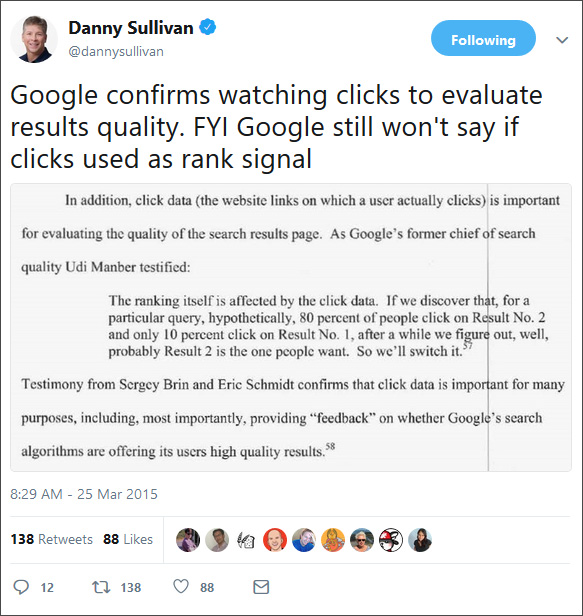
And in fact, Google's Search Console tells you what your overall click-through rate is, as well as your click-through rate per search term:
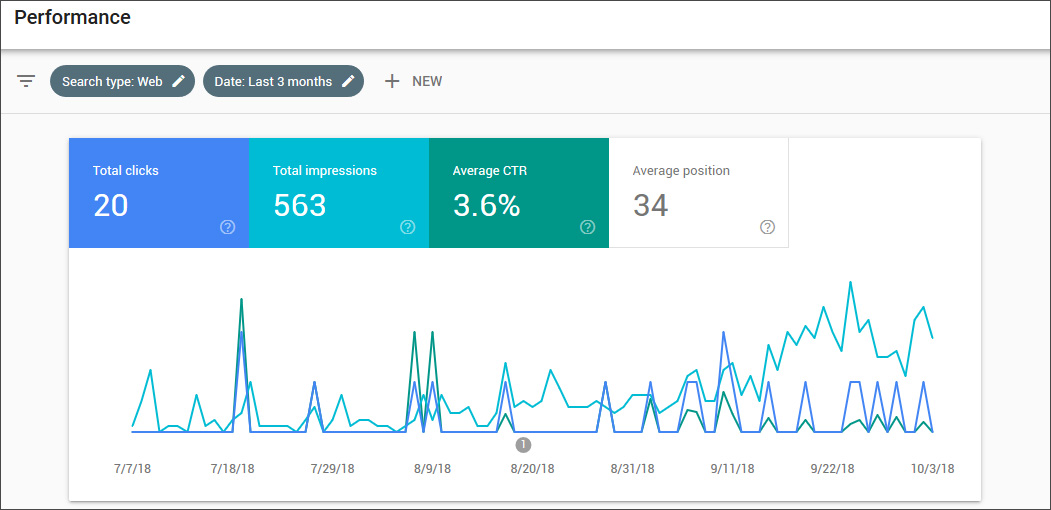
I've been playing with SERP clicks myself a few times just to test this feature out and get screenshots (no, I'm not going to wear the black hat and do it more often).
Overall, I noticed a difference every time I made that extra click.
Below is an example of the ranking changes I saw in a 24-hour time period after clicking my result in the SERPs:
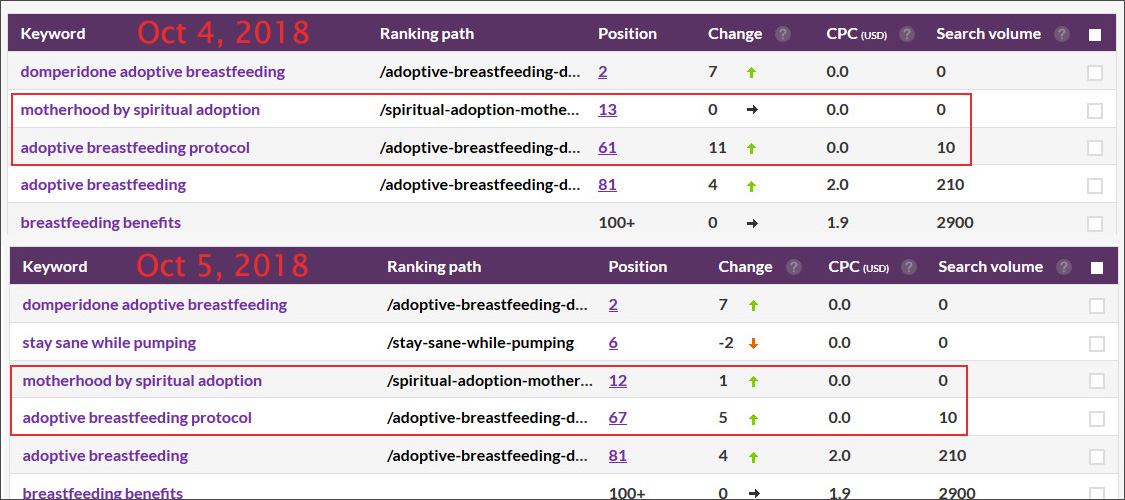
What happened here?
- My ranking for "motherhood by spiritual adoption" went up one position, from #13 to #12
- My ranking for "adoptive breastfeeding protocol" recovered five positions overnight, after dropping from #61 to #72 and then going up again to #67
I'm looking forward to seeing major changes as impressions for this website increase. I've been working on a few things to encourage searchers to click on my results and improve my CTR.
Here are some short, sweet and practical ways to do this for your own site:
- Optimize your existing headlines for the keywords you're trying to rank for
- Optimize those headlines again for psychological impact—make use of emotional, powerful words to get the searcher to think "I need this!" and click on the result
- Avoid unethical clickbait titles
- Do the same with your meta description (don't forget to add one to each blog post and page on your site!)
- A/B test new headlines following the same principles stated above
I've seen traffic and rankings for my main websites improve using just these steps!
Sometimes the simplest things are the ones that work best.
Final Thoughts on Ranking Without Backlinks
So, is it really possible to rank without backlinks?
Of course it is! I doubt you have any more... doubts left, by this point.
I'm like you, trying to get the most out of my SEO strategy without relying heavily on link building.
Doing it this way means you can count on your own platform to do most of the work toward your placement in search engines, and any external signals simply help boost that work.
It's owning your rankings.
And once you've given your site a good audit and optimized it with the strategies and techniques you learned in this article, link building will start to come naturally.
In the end, all it takes is a single high-quality blog post to get that one incredible backlink and boost the rankings you've already worked so hard to get!










